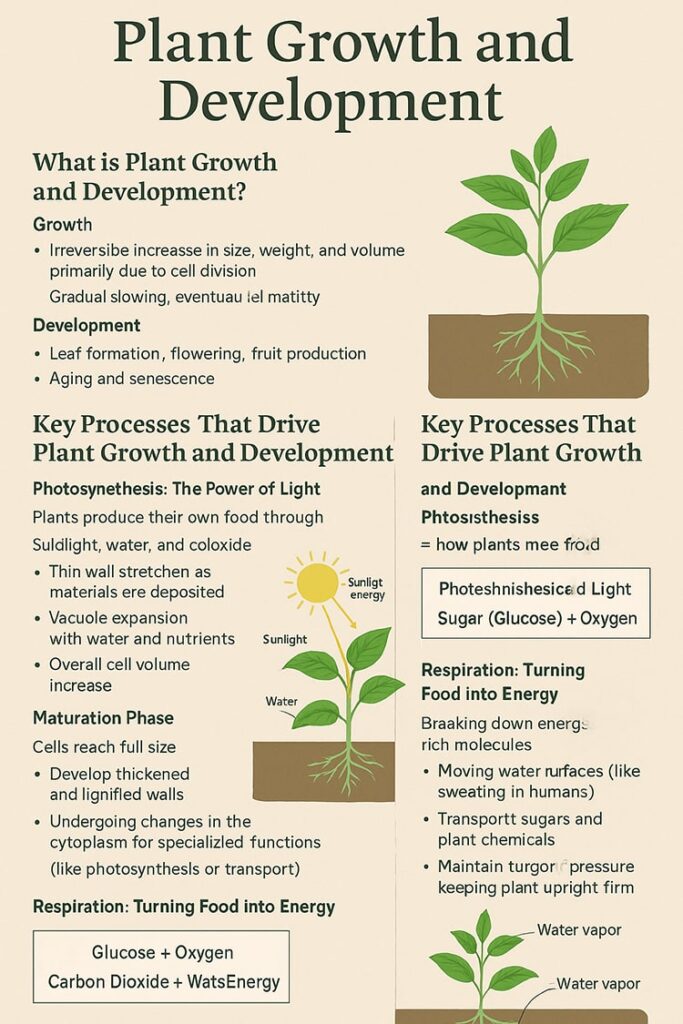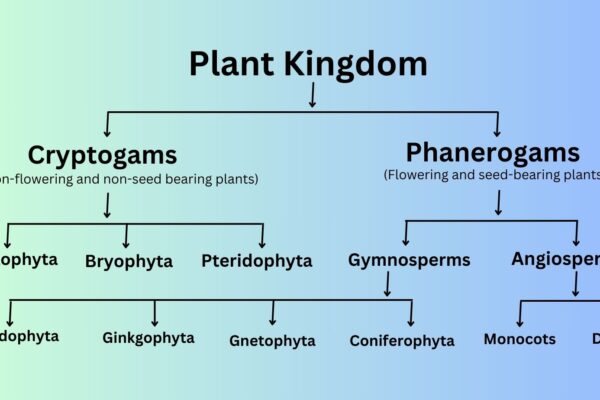When you plant a seed in soil — whether in a garden bed or a pot — something remarkable begins. In just a few days, a tiny sprout appears, eventually growing taller, developing leaves, and maturing into a full-grown plant that may flower or bear fruit. This entire journey is known as plant growth and development.
In this article, we’ll explore how plants grow, what drives their development, and why understanding this process is essential for gardeners, students, and plant lovers alike.

What Is Plant Growth and Development?
All living organisms grow — but how does this happen in plants?
Growth
Plant growth refers to the irreversible increase in size, weight, and volume of a plant, primarily driven by cell division. As cells divide and expand, the plant increases in height, width, and complexity.
Growth is most active in young plants and gradually slows as the plant matures. Eventually, growth stops altogether, leading to the final stage of life.
Development
Development includes all the changes a plant goes through from germination to death, such as:
- Leaf formation
- Flowering
- Fruit production
- Aging and senescence
While growth refers to size, development covers the entire life cycle and functional transformation of the plant.
The Phases of Plant Growth
Plant growth doesn’t happen all at once — it occurs in three distinct phases, each with a specific function and purpose:
1. Meristematic Phase (Formative Phase)
This phase occurs in actively dividing cells located at the apices (tips) of roots and shoots. These cells are crucial to initiating new growth and are characterized by:
- Thin, flexible cell walls made of cellulose
- High metabolic activity
- Numerous plasmodesmata, which are channels for nutrient and information transport between cells
The meristematic phase lays the foundation for a plant’s growth and shapes the future structure of its organs.
2. Elongation Phase
In this phase, cells that were formed in the meristematic region begin to expand and elongate. This is how the plant increases in height or root depth. It includes:
- Stretching of the cell wall as new material is deposited
- Expansion of the vacuole, which fills with water and dissolved nutrients
- A noticeable increase in cell volume
This elongation pushes the plant’s tissues upward (shoots) or downward (roots), allowing better access to light or water.
3. Maturation Phase
Also called the differentiation phase, this is when cells:
- Reach their maximum size
- Develop thickened and often lignified cell walls (providing strength and structure)
- Undergo changes in the protoplasm (internal cell material) to take on specialized functions, such as photosynthesis in leaf cells or water transport in xylem cells
These mature cells contribute to the functional capacity and stability of the plant, forming permanent tissues.
Key Processes That Drive Plant Growth and Development
To grow and develop properly, a plant relies on three essential physiological processes:
- Photosynthesis — how plants make their own food
- Respiration — how plants convert that food into usable energy
- Transpiration — how water and nutrients move through the plant
Let’s take a closer look at each one.
Photosynthesis: The Power of Light
Unlike animals, plants can produce their own food through a process called photosynthesis. Using sunlight, water, and carbon dioxide, they create glucose (a simple sugar) and release oxygen into the air.
Photosynthesis Equation:
Carbon dioxide + Water → Sugar (Glucose) + Oxygen
CO₂ + H₂O → C₆H₁₂O₆ + O₂
How It Works:
- The energy required for the process is captured from sunlight, which activates the chlorophyll pigments in the plant’s leaves.
- Carbon dioxide (CO₂) enters the plant through stomata (tiny openings in the leaves).
- Water (H₂O) enters the plant through the root system and travels upward through specialized vascular tissue, reaching the leaves where it participates in photosynthesis.
The resulting glucose is used by the plant for immediate energy or growth. Excess glucose is stored in the stems, roots, or fruits as starch, oils, or other compounds. This stored energy becomes the fuel for respiration.
Environmental Factors Affecting Photosynthesis
Several external elements influence how well a plant can photosynthesize:
- Light: More light = faster photosynthesis
Example: Tomato plants produce more fruit in full sun - Water: Needed for mineral transport and cell pressure; must be balanced (not too dry or soggy)
- Carbon Dioxide: Enters via stomata and is usually abundant in the air
- Temperature: Ideal range is 65°F to 85°F (18°C to 27°C); extreme temperatures slow the process
Real-Life Example: Boosting Basil Growth with Better Light
Maria, a home gardener in Texas, noticed her basil plants growing slowly. After adjusting for better sunlight and spacing, photosynthesis improved — and within 2 weeks, growth doubled.
Respiration: Turning Food into Energy
While photosynthesis builds energy-rich molecules, respiration is the process that breaks them down to release usable energy for the plant’s needs.
Respiration Equation:
Glucose + Oxygen → Carbon Dioxide + Water + Energy
C₆H₁₂O₆ + 6O₂ → 6CO₂ + 6H₂O + Energy
Why It Matters:
- Respiration powers cell division, nutrient transport, and the development of roots, stems, and leaves
- It occurs in all living cells of the plant, day and night
- It is the reverse of photosynthesis, but more complex than simply running the reaction backward
Simple Analogy:
- Photosynthesis = building process
- Respiration = breaking-down process
Transpiration: The Plant’s Cooling & Transport System
Transpiration refers to the release of water vapor from plant leaves, especially through small openings called stomata, as part of the plant’s natural water cycle. Though it may seem like wasteful water loss, it is a vital physiological function.
Why It Matters:
- Moves water and minerals from roots to leaves
- Cools plant surfaces (similar to sweating in humans)
- Distributes sugars and plant chemicals
- Maintains turgor pressure to keep the plant upright and firm
Real-Life Example: Saving Cucumber Vines in a Heatwave
Last summer, Kevin, a home gardener in southern California, noticed his cucumber vines wilting by mid-afternoon, despite regular morning watering. The plants had plenty of sunlight, but growth had slowed, and new leaves were yellowing.
After reading about transpiration, Kevin realized that high temperatures and dry winds were accelerating water loss through the leaves. He installed shade cloth to reduce afternoon sun intensity and started mulching around the base of each plant to retain soil moisture.
Within a week, leaf wilt reduced significantly, and by the end of the month, the plants had recovered and were producing healthy cucumbers again. Understanding how transpiration interacts with temperature helped him adapt his care routine and save his crop.
Environmental Factors That Affect Transpiration:
- Temperature: Higher temperature increases water loss
- Humidity: Lower humidity = faster transpiration
- Wind: Increases evaporation by drying leaf surfaces
As temperature or wind increases, guard cells shrink and stomata open wider — this accelerates the rate of transpiration.
The Balance Between Photosynthesis, Respiration, and Transpiration
For a plant to truly thrive, it must maintain a delicate balance between its three core physiological processes. These systems are interconnected, and any imbalance can impact plant health, energy use, and productivity.
If Photosynthesis Is Too High…
But respiration is too low, the plant won’t be able to convert the sugars into usable energy. This results in energy overload, and the plant may slow or halt photosynthesis altogether.
If Respiration Is Too High…
But photosynthesis is too low, the plant may burn through energy reserves faster than it can replenish them. This leads to poor growth, weak structure, and potential decline.
If Transpiration Is Disrupted…
By drought, excessive humidity, or stomatal damage, water and mineral transport suffers. This impacts not just hydration but also nutrient delivery and cooling, leading to stunted growth or heat stress.
In nature, most healthy plants are self-regulating and manage this balance efficiently. However, for gardeners, farmers, and plant enthusiasts, understanding these dynamics allows for better decisions and care routines that boost health and productivity.
Final Thoughts: Why This Matters
Understanding plant growth and development isn’t just for scientists — it’s essential knowledge for every gardener, grower, or student of nature. Whether you’re nurturing herbs in a sunny kitchen or managing crops across acres, these biological processes are always at play.
When you understand how plants grow and what they need, you can:
- Make smarter decisions about watering, fertilizing, and pruning
- Recognize signs of stress, deficiency, or imbalance earlier
- Choose the right plants for your growing conditions
In short, mastering the basics of plant growth and development leads to healthier gardens, higher yields, and a deeper connection with the green world around you.
FAQs
Q: What is the difference between growth and development in plants?
A: Growth is the increase in size or mass, while development includes all life cycle changes like flowering and fruiting.
Q: Why is photosynthesis important for plant growth?
A: It produces the glucose that powers all growth and biological functions.
Q: What environmental factors affect photosynthesis?
A: Light, water, CO₂ levels, and temperature all play key roles.


